2017 NISSAN SENTRA Rear wheel
[x] Cancel search: Rear wheelPage 439 of 491
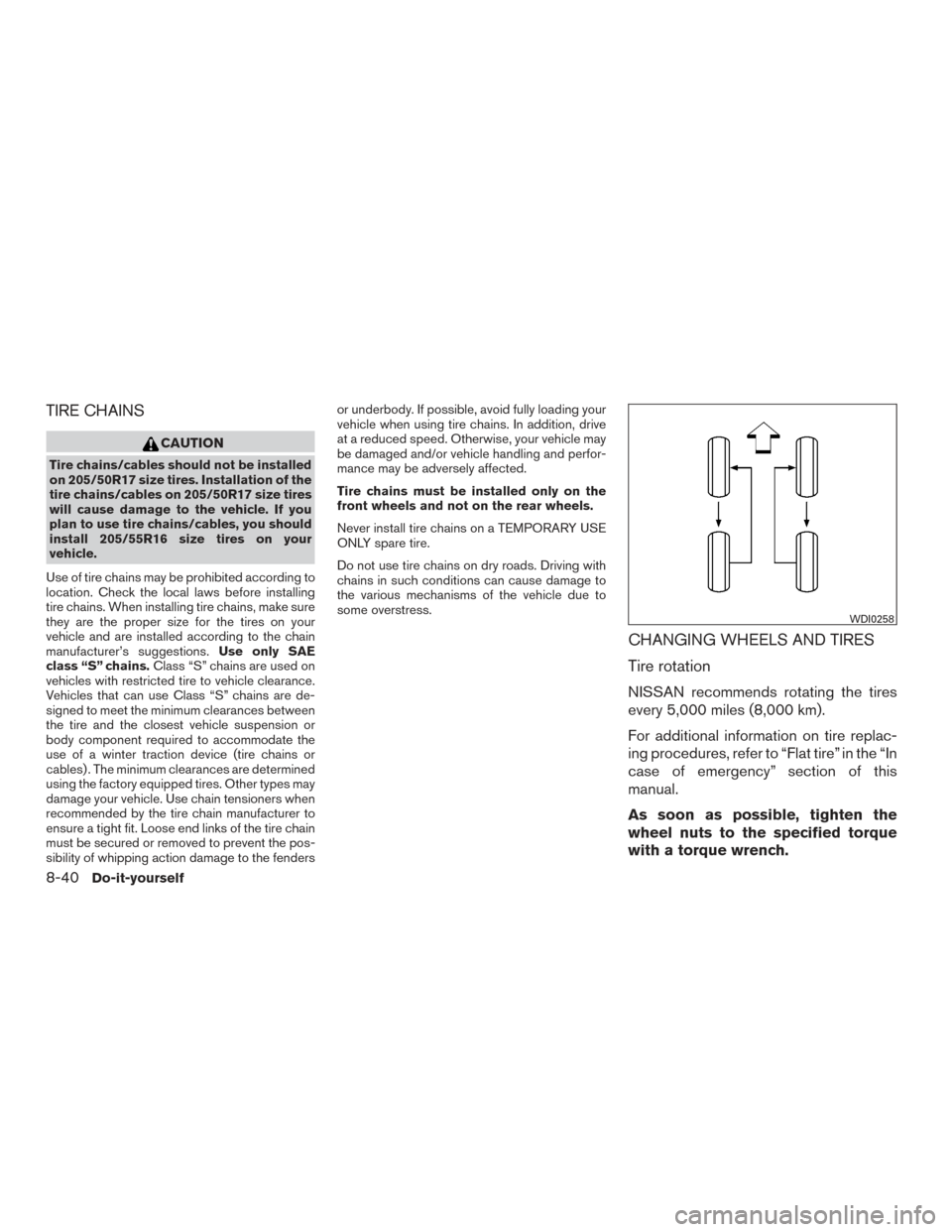
TIRE CHAINS
CAUTION
Tire chains/cables should not be installed
on 205/50R17 size tires. Installation of the
tire chains/cables on 205/50R17 size tires
will cause damage to the vehicle. If you
plan to use tire chains/cables, you should
install 205/55R16 size tires on your
vehicle.
Use of tire chains may be prohibited according to
location. Check the local laws before installing
tire chains. When installing tire chains, make sure
they are the proper size for the tires on your
vehicle and are installed according to the chain
manufacturer’s suggestions. Use only SAE
class “S” chains. Class “S” chains are used on
vehicles with restricted tire to vehicle clearance.
Vehicles that can use Class “S” chains are de-
signed to meet the minimum clearances between
the tire and the closest vehicle suspension or
body component required to accommodate the
use of a winter traction device (tire chains or
cables) . The minimum clearances are determined
using the factory equipped tires. Other types may
damage your vehicle. Use chain tensioners when
recommended by the tire chain manufacturer to
ensure a tight fit. Loose end links of the tire chain
must be secured or removed to prevent the pos-
sibility of whipping action damage to the fenders or underbody. If possible, avoid fully loading your
vehicle when using tire chains. In addition, drive
at a reduced speed. Otherwise, your vehicle may
be damaged and/or vehicle handling and perfor-
mance may be adversely affected.
Tire chains must be installed only on the
front wheels and not on the rear wheels.
Never install tire chains on a TEMPORARY USE
ONLY spare tire.
Do not use tire chains on dry roads. Driving with
chains in such conditions can cause damage to
the various mechanisms of the vehicle due to
some overstress.
CHANGING WHEELS AND TIRES
Tire rotation
NISSAN recommends rotating the tires
every 5,000 miles (8,000 km).
For additional information on tire replac-
ing procedures, refer to “Flat tire” in the “In
case of emergency” section of this
manual.
As soon as possible, tighten the
wheel nuts to the specified torque
with a torque wrench.
WDI0258
8-40Do-it-yourself
Page 441 of 491
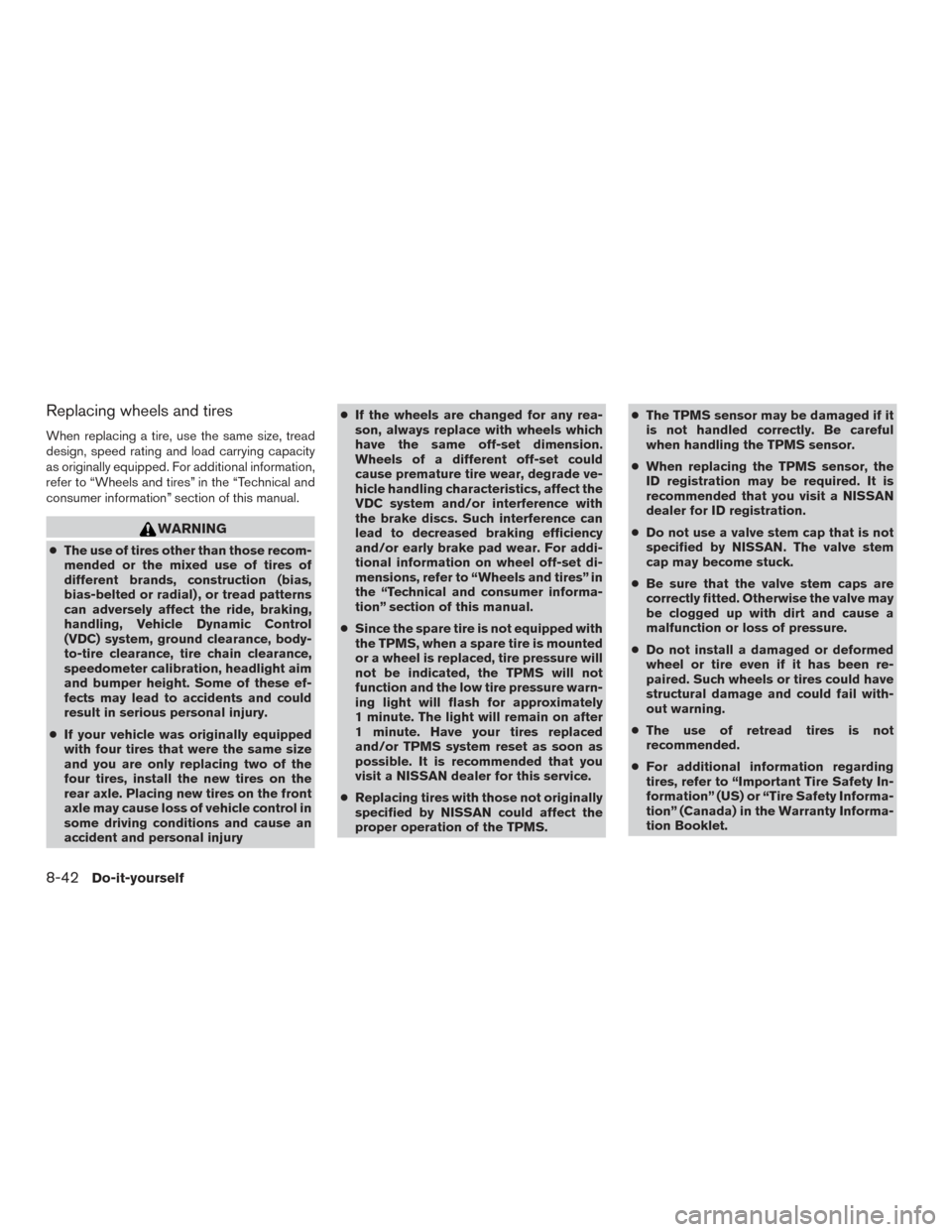
Replacing wheels and tires
When replacing a tire, use the same size, tread
design, speed rating and load carrying capacity
as originally equipped. For additional information,
refer to “Wheels and tires” in the “Technical and
consumer information” section of this manual.
WARNING
●The use of tires other than those recom-
mended or the mixed use of tires of
different brands, construction (bias,
bias-belted or radial) , or tread patterns
can adversely affect the ride, braking,
handling, Vehicle Dynamic Control
(VDC) system, ground clearance, body-
to-tire clearance, tire chain clearance,
speedometer calibration, headlight aim
and bumper height. Some of these ef-
fects may lead to accidents and could
result in serious personal injury.
● If your vehicle was originally equipped
with four tires that were the same size
and you are only replacing two of the
four tires, install the new tires on the
rear axle. Placing new tires on the front
axle may cause loss of vehicle control in
some driving conditions and cause an
accident and personal injury ●
If the wheels are changed for any rea-
son, always replace with wheels which
have the same off-set dimension.
Wheels of a different off-set could
cause premature tire wear, degrade ve-
hicle handling characteristics, affect the
VDC system and/or interference with
the brake discs. Such interference can
lead to decreased braking efficiency
and/or early brake pad wear. For addi-
tional information on wheel off-set di-
mensions, refer to “Wheels and tires” in
the “Technical and consumer informa-
tion” section of this manual.
● Since the spare tire is not equipped with
the TPMS, when a spare tire is mounted
or a wheel is replaced, tire pressure will
not be indicated, the TPMS will not
function and the low tire pressure warn-
ing light will flash for approximately
1 minute. The light will remain on after
1 minute. Have your tires replaced
and/or TPMS system reset as soon as
possible. It is recommended that you
visit a NISSAN dealer for this service.
● Replacing tires with those not originally
specified by NISSAN could affect the
proper operation of the TPMS. ●
The TPMS sensor may be damaged if it
is not handled correctly. Be careful
when handling the TPMS sensor.
● When replacing the TPMS sensor, the
ID registration may be required. It is
recommended that you visit a NISSAN
dealer for ID registration.
● Do not use a valve stem cap that is not
specified by NISSAN. The valve stem
cap may become stuck.
● Be sure that the valve stem caps are
correctly fitted. Otherwise the valve may
be clogged up with dirt and cause a
malfunction or loss of pressure.
● Do not install a damaged or deformed
wheel or tire even if it has been re-
paired. Such wheels or tires could have
structural damage and could fail with-
out warning.
● The use of retread tires is not
recommended.
● For additional information regarding
tires, refer to “Important Tire Safety In-
formation” (US) or “Tire Safety Informa-
tion” (Canada) in the Warranty Informa-
tion Booklet.
8-42Do-it-yourself
Page 442 of 491
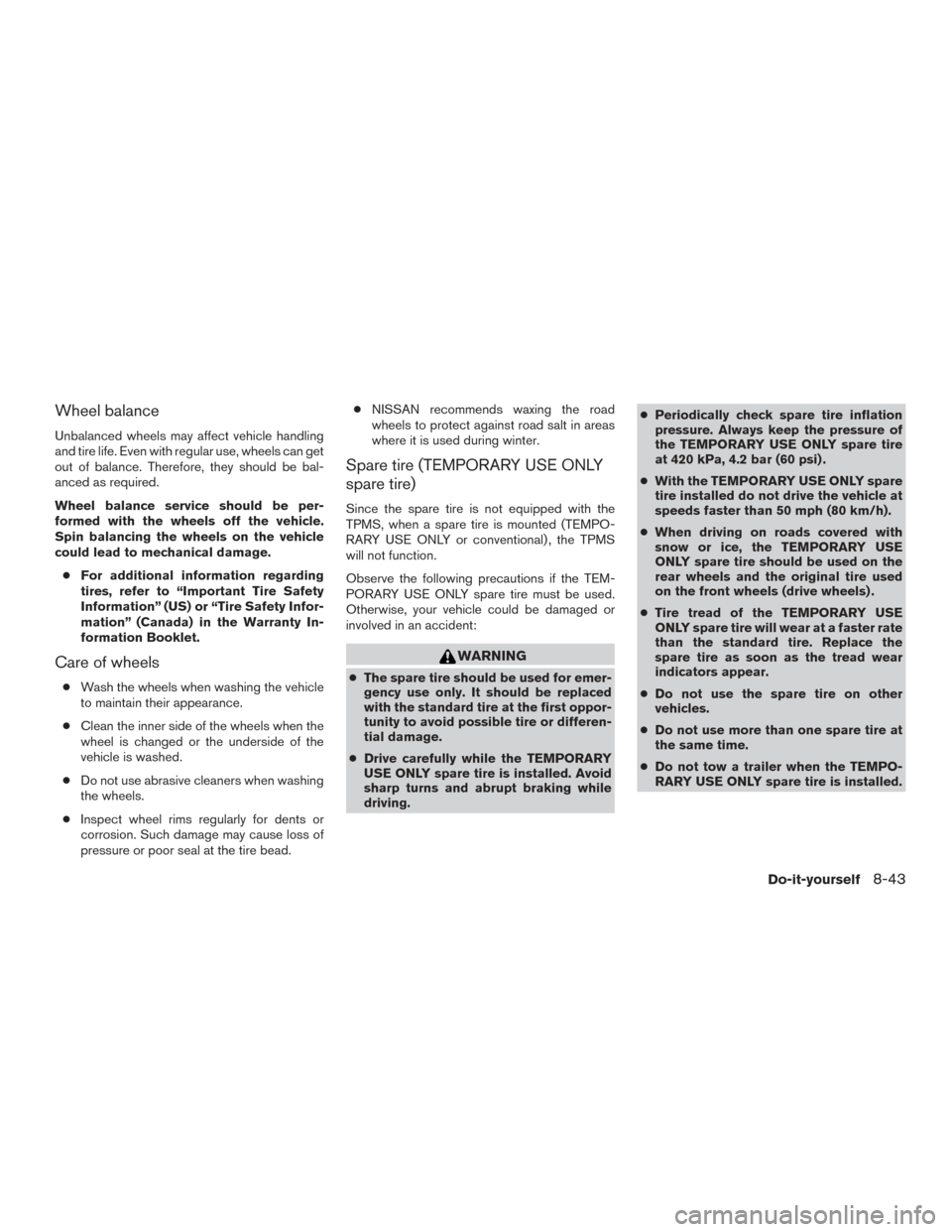
Wheel balance
Unbalanced wheels may affect vehicle handling
and tire life. Even with regular use, wheels can get
out of balance. Therefore, they should be bal-
anced as required.
Wheel balance service should be per-
formed with the wheels off the vehicle.
Spin balancing the wheels on the vehicle
could lead to mechanical damage.● For additional information regarding
tires, refer to “Important Tire Safety
Information” (US) or “Tire Safety Infor-
mation” (Canada) in the Warranty In-
formation Booklet.
Care of wheels
● Wash the wheels when washing the vehicle
to maintain their appearance.
● Clean the inner side of the wheels when the
wheel is changed or the underside of the
vehicle is washed.
● Do not use abrasive cleaners when washing
the wheels.
● Inspect wheel rims regularly for dents or
corrosion. Such damage may cause loss of
pressure or poor seal at the tire bead. ●
NISSAN recommends waxing the road
wheels to protect against road salt in areas
where it is used during winter.
Spare tire (TEMPORARY USE ONLY
spare tire)
Since the spare tire is not equipped with the
TPMS, when a spare tire is mounted (TEMPO-
RARY USE ONLY or conventional) , the TPMS
will not function.
Observe the following precautions if the TEM-
PORARY USE ONLY spare tire must be used.
Otherwise, your vehicle could be damaged or
involved in an accident:
WARNING
● The spare tire should be used for emer-
gency use only. It should be replaced
with the standard tire at the first oppor-
tunity to avoid possible tire or differen-
tial damage.
● Drive carefully while the TEMPORARY
USE ONLY spare tire is installed. Avoid
sharp turns and abrupt braking while
driving. ●
Periodically check spare tire inflation
pressure. Always keep the pressure of
the TEMPORARY USE ONLY spare tire
at 420 kPa, 4.2 bar (60 psi) .
● With the TEMPORARY USE ONLY spare
tire installed do not drive the vehicle at
speeds faster than 50 mph (80 km/h).
● When driving on roads covered with
snow or ice, the TEMPORARY USE
ONLY spare tire should be used on the
rear wheels and the original tire used
on the front wheels (drive wheels) .
● Tire tread of the TEMPORARY USE
ONLY spare tire will wear at a faster rate
than the standard tire. Replace the
spare tire as soon as the tread wear
indicators appear.
● Do not use the spare tire on other
vehicles.
● Do not use more than one spare tire at
the same time.
● Do not tow a trailer when the TEMPO-
RARY USE ONLY spare tire is installed.
Do-it-yourself8-43
Page 469 of 491
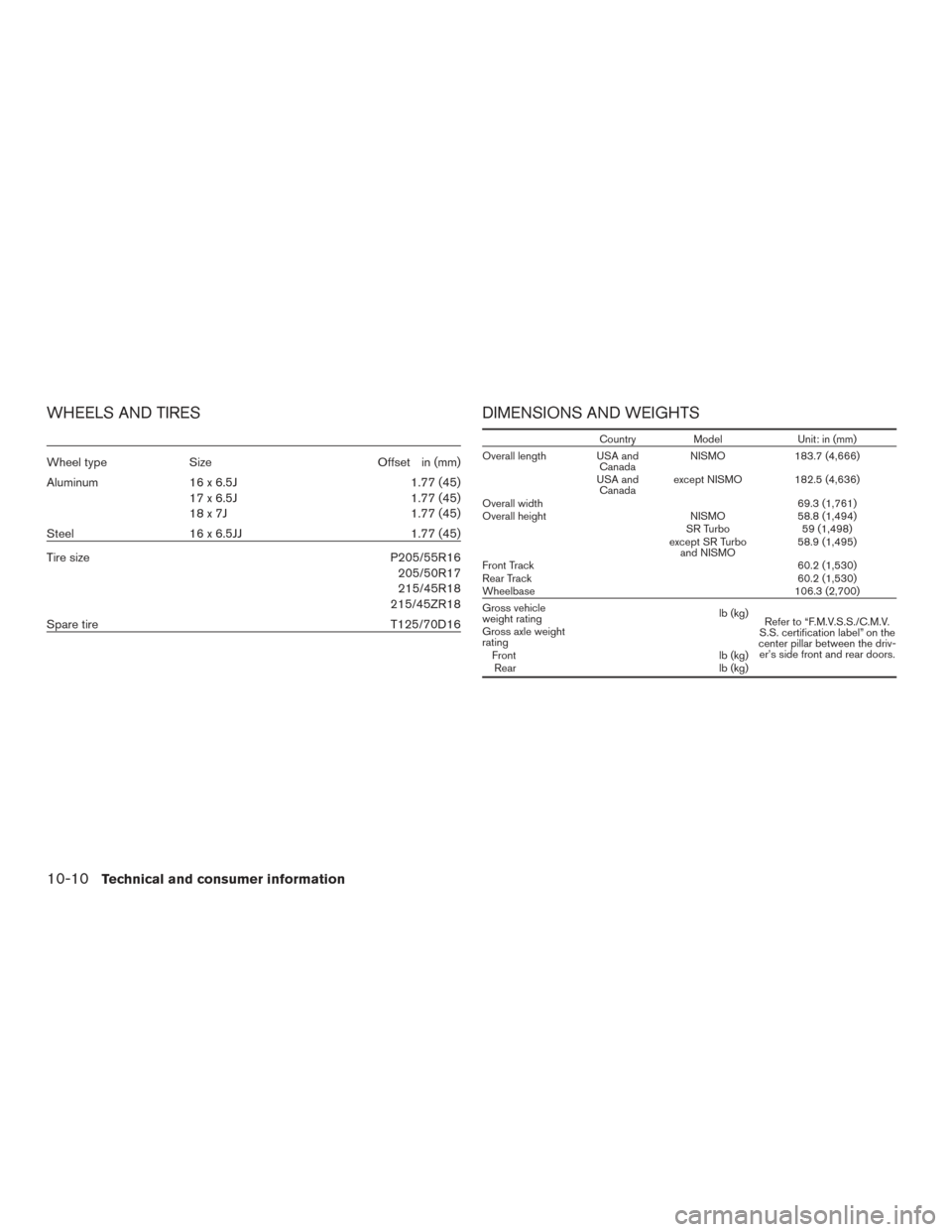
WHEELS AND TIRES
Wheel typeSize Offset in (mm)
Aluminum 16 x 6.5J
17x6.5J
18x7J 1.77 (45)
1.77 (45)
1.77 (45)
Steel 16 x 6.5JJ 1.77 (45)
Tire size P205/55R16
205/50R17
215/45R18
215/45ZR18
Spare tire T125/70D16
DIMENSIONS AND WEIGHTS
CountryModel Unit: in (mm)
Overall length USA and CanadaNISMO
183.7 (4,666)
USA and Canada except NISMO 182.5 (4,636)
Overall width 69.3 (1,761)
Overall height NISMO58.8 (1,494)
SR Turbo 59 (1,498)
except SR Turbo and NISMO 58.9 (1,495)
Front Track 60.2 (1,530)
Rear Track 60.2 (1,530)
Wheelbase 106.3 (2,700)
Gross vehicle
weight rating lb (kg)
Refer to “F.M.V.S.S./C.M.V.
S.S. certification label” on the
center pillar between the driv- er’s side front and rear doors.
Gross axle weight
rating
Front lb (kg)
Rear lb (kg)
10-10Technical and consumer information
Page 476 of 491

5. Determine the combined weight ofluggage and cargo being loaded on
the vehicle. That weight may not
safely exceed the available cargo and
luggage load capacity calculated in
step 4.
Before driving a loaded vehicle, confirm
that you do not exceed the Gross Vehicle
Weight Rating (GVWR) or the Gross Axle
Weight Rating (GAWR) for your vehicle.
For additional information, refer to “Mea-
surement of weights” in this section.
Also check tires for proper inflation pres-
sures. For additional information, refer to
“Tire and Loading Information label” in this
section.
LOADING TIPS
● The GVW must not exceed GVWR
or GAWR as specified on the
F.M.V.S.S./C.M.V.S.S. certification
label.
● Do not load the front and rear axle to
the GAWR. Doing so will exceed the
GVWR.
WARNING
● Properly secure all cargo with
ropes or straps to help prevent it
from sliding or shifting. Do not
place cargo higher than the seat-
backs. In a sudden stop or colli-
sion, unsecured cargo could
cause personal injury.
● Do not load your vehicle any
heavier than the GVWR or the
maximum front and rear GAWRs.
If you do, parts of your vehicle can
break, tire damage could occur,
or it can change the way your
vehicle handles. This could result
in loss of control and cause per-
sonal injury.
● Overloading not only can shorten
the life of your vehicle and the
tire, but can also cause unsafe
vehicle handling and longer brak-
ing distances. This may cause a
premature tire failure which
could result in a serious accident
and personal injury. Failures
caused by overloading are not
covered by the vehicle’s warranty.MEASUREMENT OF WEIGHTS
Secure loose items to prevent weight
shifts that could affect the balance of your
vehicle. When the vehicle is loaded, drive
to a scale and weigh the front and the rear
wheels separately to determine axle
loads. Individual axle loads should not ex-
ceed either of the gross axle weight rat-
ings (GAWR) . The total of the axle loads
should not exceed the gross vehicle
weight rating (GVWR) . These ratings are
given on the vehicle certification label. If
weight ratings are exceeded, move or re-
move items to bring all weights below the
ratings.
Technical and consumer information10-17
Page 483 of 491
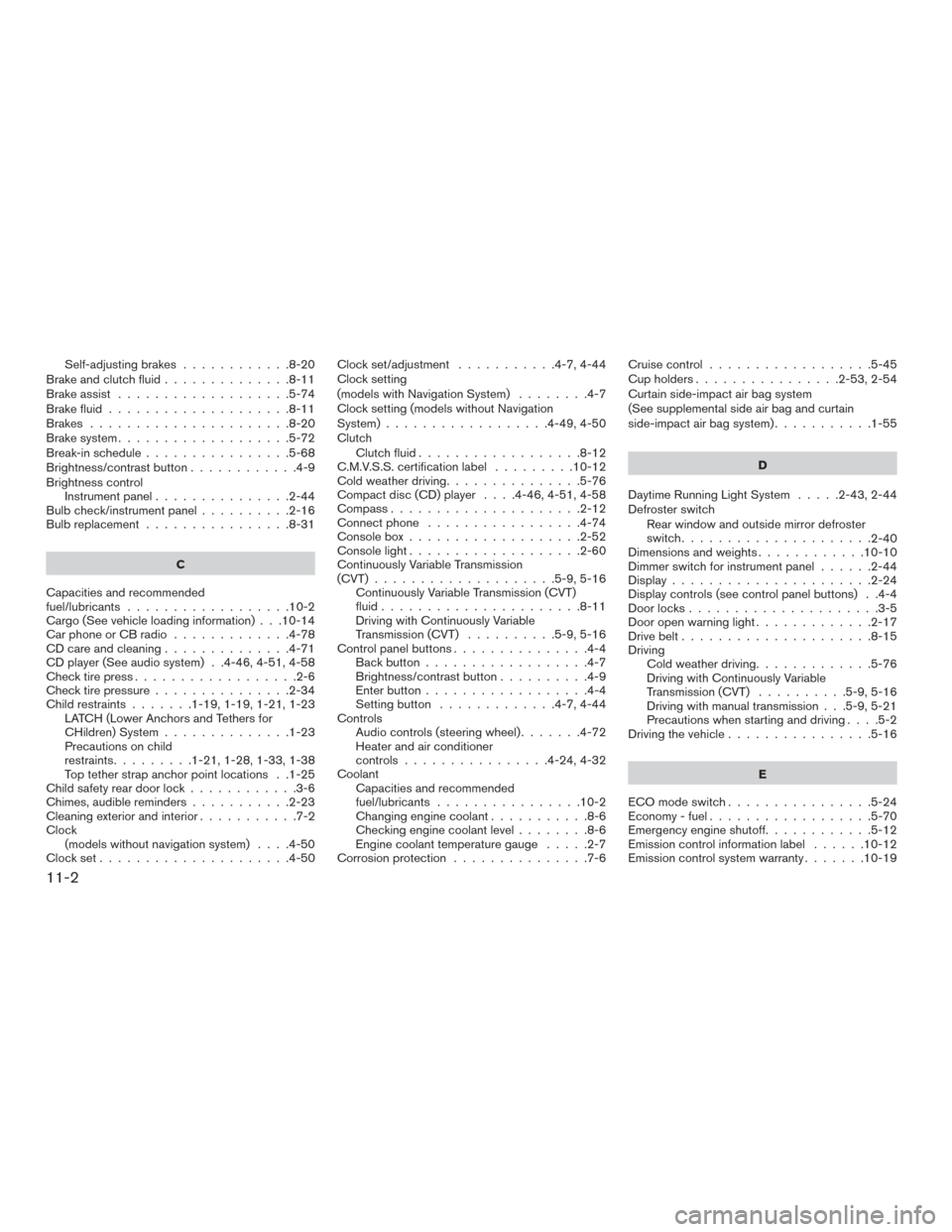
Self-adjusting brakes............8-20
Brake and clutch fluid ..............8-11
Brake assist ...................5-74
Brake fluid ....................8-11
Brakes ......................8-20
Brake system ...................5-72
Break-in schedule ................5-68
Brightness/contrastbutton............4-9
Brightness control Instrument panel ...............2-44
Bulb check/instrument panel ..........2-16
Bulb replacement ................8-31
C
Capacities and recommended
fuel/lubricants ..................10-2
Cargo (See vehicle loading information) . . .10-14
Car phone or CB radio .............4-78
CD care and cleaning ..............4-71
CD player (See audio system) . .4-46, 4-51, 4-58
Check tire press ..................2-6
Check tire pressure ...............2-34
Child restraints .......1-19,1-19,1-21,1-23
LATCH (Lower Anchors and Tethers for
CHildren) System ..............1-23
Precautions on child
restraints.........1-21,1-28,1-33,1-38
Top tether strap anchor point locations . .1-25
Child safety rear door lock ............3-6
Chimes, audible reminders ...........2-23
Cleaningexteriorandinterior...........7-2
Clock (models without navigation system) ....4-50
Clockset.....................4-50 Clock set/adjustment
...........4-7,4-44
Clock setting
(models with Navigation System) ........4-7
Clock setting (models without Navigation
System) ..................4-49,4-50
Clutch Clutch fluid ..................8-12
C.M.V.S.S. certification label .........10-12
Cold weather driving ...............5-76
Compact disc (CD) player ....4-46,4-51,4-58
Compass .....................2-12
Connect phone .................4-74
Console box ...................2-52
Console light ...................2-60
Continuously Variable Transmission
(CVT) ....................5-9,5-16
Continuously Variable Transmission (CVT)
fluid......................8-11
Driving with Continuously Variable
Transmission (CVT) ..........5-9,5-16
Control panel buttons ...............4-4
Back button ..................4-7
Brightness/contrast button ..........4-9
Enterbutton..................4-4
Setting button .............4-7,4-44
Controls Audio controls (steering wheel) .......4-72
Heater and air conditioner
controls................4-24,4-32
Coolant Capacities and recommended
fuel/lubricants ................10-2
Changingenginecoolant...........8-6
Checking engine coolant level ........8-6
Engine coolant temperature gauge .....2-7
Corrosion protection ...............7-6 Cruisecontrol..................5-45
Cupholders................2-53,2-54
Curtain side-impact air bag system
(See supplemental side air bag and curtain
side-impact air bag system)
...........1-55
D
Daytime Running Light System .....2-43,2-44
Defroster switch Rear window and outside mirror defroster
switch .....................
2-40
Dimensionsandweights............10-10
Dimmer switch for instrument panel ......2-44
Display......................2-24
Display controls (see control panel buttons) . .4-4
Door locks .....................3-5
Door open warning light .............2-17
Drive belt .....................8-15
Driving Cold weather driving .............5-76
Driving with Continuously Variable
Transmission (CVT) ..........5-9,5-16
Driving with manual transmission . . .5-9, 5-21
Precautions when starting and driving ....5-2
Driving the vehicle ................5-16
E
ECO mode switch ................5-24
Economy-fuel..................5-70
Emergency engine shutoff ............5-12
Emission control information label ......10-12
Emission control system warranty .......10-19
11-2
Page 487 of 491
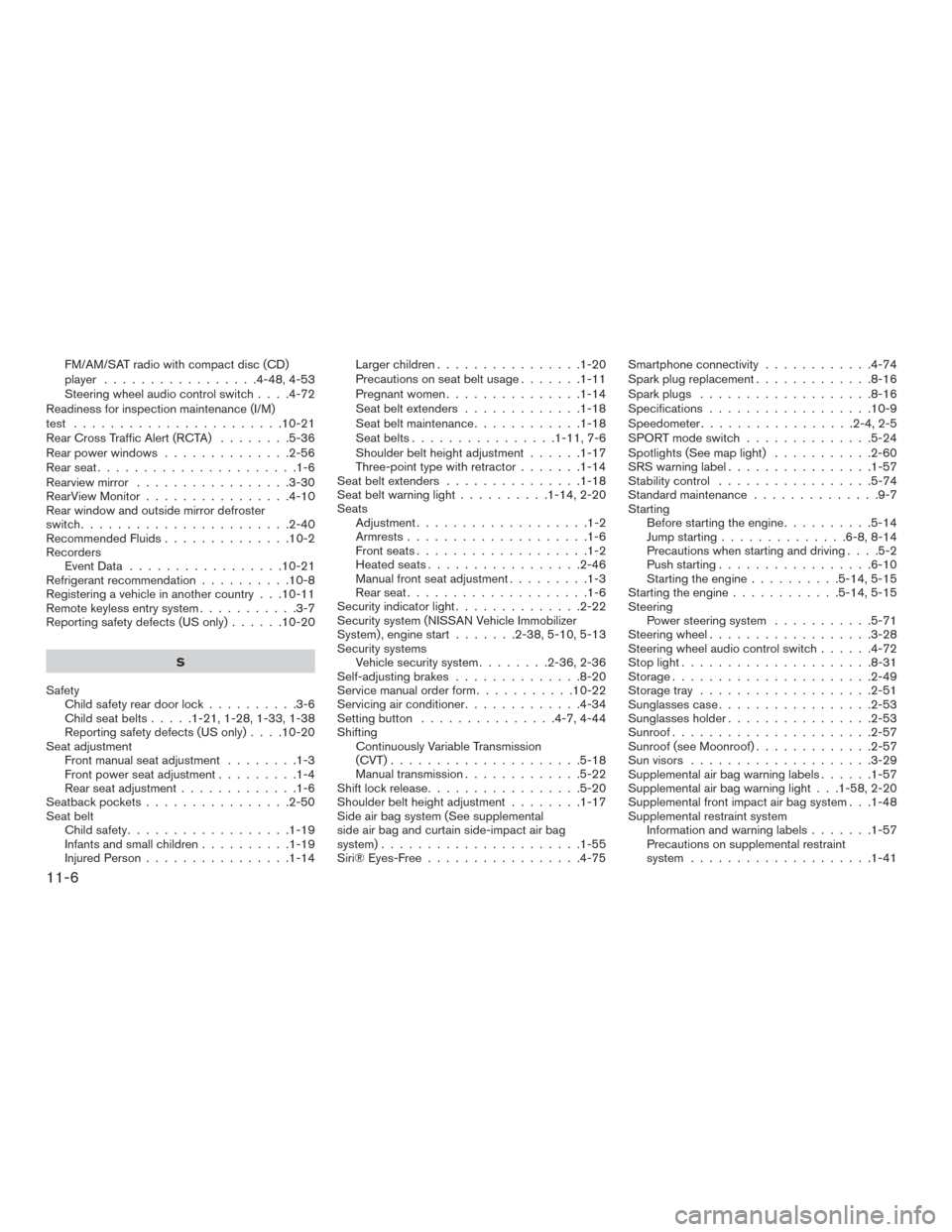
FM/AM/SAT radio with compact disc (CD)
player.................4-48,4-53
Steering wheel audio control switch ....4-72
Readiness for inspection maintenance (I/M)
test .......................10-21
Rear Cross Traffic Alert (RCTA) ........5-36
Rear power windows ..............2-56
Rearseat......................1-6
Rearview mirror .................3-30
RearViewMonitor................4-10
Rear window and outside mirror defroster
switch .......................2-40
Recommended Fluids ..............10-2
Recorders EventData .................10-21
Refrigerant recommendation ..........10-8
Registering a vehicle in another country . . .10-11
Remote keyless entry system ...........3-7
Reporting safety defects (US only) ......10-20
S
Safety Child safety rear door lock ..........3-6
Childseatbelts.....1-21,1-28,1-33,1-38
Reporting safety defects (US only) ....10-20
Seat adjustment Front manual seat adjustment ........1-3
Front power seat adjustment .........1-4
Rear seat adjustment .............1-6
Seatback pockets ................2-50
Seat belt Childsafety..................1-19
Infantsandsmallchildren..........1-19
Injured Person ................1-14 Larger children
................1-20
Precautions on seat belt usage .......1-11
Pregnant women ...............1-14
Seat belt extenders .............1-18
Seatbeltmaintenance............1-18
Seatbelts................1-11,7-6
Shoulder belt height adjustment ......1-17
Three-point type with retractor .......1-14
Seatbeltextenders ...............1-18
Seat belt warning light ..........1-14,2-20
Seats Adjustment...................1-2
Armrests ....................1-6
Frontseats...................1-2
Heatedseats.................2-46
Manual front seat adjustment .........1-3
Rearseat....................1-6
Security indicator light ..............2-22
Security system (NISSAN Vehicle Immobilizer
System) , engine start .......2-38,5-10,5-13
Security systems Vehicle security system ........2-36,2-36
Self-adjusting brakes ..............8-20
Service manual order form ...........10-22
Servicing air conditioner .............4-34
Setting button ...............4-7,4-44
Shifting Continuously Variable Transmission
(CVT) .....................5-18
Manual transmission .............5-22
Shiftlockrelease.................5-20
Shoulder belt height adjustment ........1-17
Side air bag system (See supplemental
side air bag and curtain side-impact air bag
system) ......................1-55
Siri® Eyes-Free .................4-75 Smartphone connectivity
............4-74
Spark plug replacement .............8-16
Sparkplugs ...................8-16
Specifications ..................10-9
Speedometer .................2-4,2-5
SPORT mode switch ..............5-24
Spotlights (See map light) ...........2-60
SRSwarninglabel................1-57
Stability control .................
5-74
Standard maintenance ..............9-7
Starting Before starting the engine ..........5-14
Jump starting ..............6-8,8-14
Precautions when starting and driving ....5-2
Push starting .................6-10
Starting the engine ..........5-14,5-15
Starting the engine ............5-14,5-15
Steering Power steering system ...........5-71
Steering wheel ..................3-28
Steering wheel audio control switch ......4-72
Stoplight.....................8-31
Storage......................2-49
Storage tray ...................2-51
Sunglasses case .................2-53
Sunglasses holder ................2-53
Sunroof......................2-57
Sunroof(seeMoonroof).............2-57
Sun visors ....................3-29
Supplemental air bag warning labels ......1-57
Supplemental air bag warning light . . .1-58, 2-20
Supplemental front impact air bag system . . .1-48
Supplemental restraint system Information and warning labels .......1-57
Precautions on supplemental restraint
system ....................1-41
11-6
Page 488 of 491
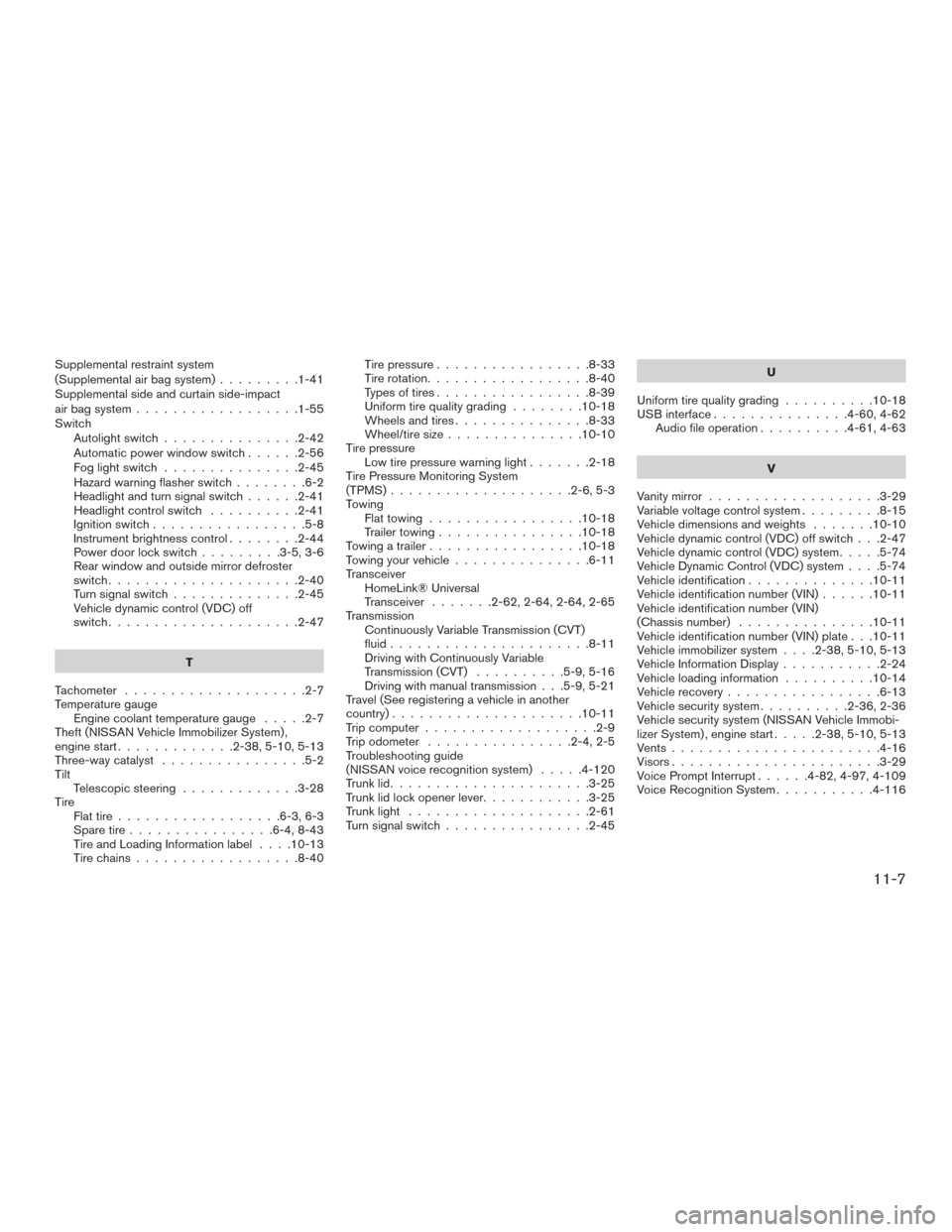
Supplemental restraint system
(Supplemental air bag system).........1-41
Supplemental side and curtain side-impact
air bag system ..................1-55
Switch Autolightswitch...............2-42
Automatic power window switch ......2-56
Foglightswitch ...............2-45
Hazard warning flasher switch ........6-2
Headlight and turn signal switch ......2-41
Headlight control switch ..........2-41
Ignition switch .................5-8
Instrument brightness control ........2-44
Power door lock switch .........3-5,3-6
Rear window and outside mirror defroster
switch.....................2-40
Turnsignalswitch..............2-45
Vehicle dynamic control (VDC) off
switch.....................2-47
T
Tachometer ....................2-7
Temperature gauge Engine coolant temperature gauge .....2-7
Theft (NISSAN Vehicle Immobilizer System) ,
engine start .............2-38,5-10,5-13
Three-way catalyst ................5-2
Tilt Telescopic steering .............3-28
Tire Flat tire ..................6-3,6-3
Spare tire ................6-4,8-43
TireandLoadingInformationlabel ....10-13
Tire chains ..................8-40 Tirepressure.................8-33
Tire rotation..................8-40
Types of tires
.................8-39
Uniform tire quality grading ........10-18
Wheels and tires ...............8-33
Wheel/tire size ...............10-10
Tire pressure Low tire pressure warning light .......2-18
Tire Pressure Monitoring System
(TPMS) ....................2-6,5-3
Towing Flattowing.................10-18
Trailer towing ................10-18
Towing a trailer .................10-18
Towingyourvehicle...............6-11
Transceiver HomeLink® Universal
Transceiver .......2-62,2-64,2-64,2-65
Transmission Continuously Variable Transmission (CVT)
fluid......................8-11
Driving with Continuously Variable
Transmission (CVT) ..........5-9,5-16
Driving with manual transmission . . .5-9, 5-21
Travel (See registering a vehicle in another
country) .....................10-11
Trip computer ...................2-9
Trip odometer ................2-4,2-5
Troubleshooting guide
(NISSAN voice recognition system) .....4-120
Trunklid......................3-25
Trunklidlockopenerlever............3-25
Trunklight ....................2-61
Turn signal switch ................2-45 U
Uniform tire quality grading ..........10-18
USB interface ...............4-60,4-62
Audio file operation ..........4-61,4-63
V
Vanity mirror ...................3-29
Variable voltage control system .........8-15
Vehicle dimensions and weights .......10-10
Vehicle dynamic control (VDC) off switch . . .2-47
Vehicle dynamic control (VDC) system .....5-74
Vehicle Dynamic Control (VDC) system . . . .5-74
Vehicle identification ..............10-11
Vehicle identification number (VIN) ......10-11
V
ehicle identification number (VIN)
(Chassis number) ...............10-11
Vehicle identification number (VIN) plate . . .10-11
Vehicle immobilizer system ....2-38,5-10,5-13
Vehicle Information Display ...........2-24
Vehicle loading information ..........10-14
Vehicle recovery .................6-13
Vehicle security system ..........2-36,2-36
Vehicle security system (NISSAN Vehicle Immobi-
lizer System) , engine start .....2-38,5-10,5-13
Vents.......................4-16
Visors.......................3-29
Voice Prompt Interrupt ......4-82,4-97,4-109
Voice Recognition System ...........4-116
11-7